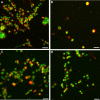Coal dust alters beta-naphthoflavone-induced aryl hydrocarbon receptor nuclear translocation in alveolar type II cells
- PMID: 19650907
- PMCID: PMC2732588
- DOI: 10.1186/1743-8977-6-21
Coal dust alters beta-naphthoflavone-induced aryl hydrocarbon receptor nuclear translocation in alveolar type II cells
Abstract
Background: Many polycyclic aromatic hydrocarbons (PAHs) can cause DNA adducts and initiate carcinogenesis. Mixed exposures to coal dust (CD) and PAHs are common in occupational settings. In the CD and PAH-exposed lung, CD increases apoptosis and causes alveolar type II (AT-II) cell hyperplasia but reduces CYP1A1 induction. Inflammation, but not apoptosis, appears etiologically associated with reduced CYP1A1 induction in this mixed exposure model. Many AT-II cells in the CD-exposed lungs have no detectable CYP1A1 induction after PAH exposure. Although AT-II cells are a small subfraction of lung cells, they are believed to be a potential progenitor cell for some lung cancers. Because CYP1A1 is induced via ligand-mediated nuclear translocation of the aryl hydrocarbon receptor (AhR), we investigated the effect of CD on PAH-induced nuclear translocation of AhR in AT-II cells isolated from in vivo-exposed rats. Rats received CD or vehicle (saline) by intratracheal (IT) instillation. Three days before sacrifice, half of the rats in each group started daily intraperitoneal injections of the PAH, beta-naphthoflavone (BNF).
Results: Fourteen days after IT CD exposure and 1 day after the last intraperitoneal BNF injection, AhR immunofluorescence indicated that proportional AhR nuclear expression and the percentage of cells with nuclear AhR were significantly increased in rats receiving IT saline and BNF injections compared to vehicle controls. However, in CD-exposed rats, BNF did not significantly alter the nuclear localization or cytosolic expression of AhR compared to rats receiving CD and oil.
Conclusion: Our findings suggest that during particle and PAH mixed exposures, CD alters the BNF-induced nuclear translocation of AhR in AT-II cells. This provides an explanation for the modification of CYP1A1 induction in these cells. Thus, this study suggests that mechanisms for reduced PAH-induced CYP1A1 activity in the CD exposed lung include not only the effects of inflammation on the lung as a whole, but also reduced PAH-associated nuclear translocation of AhR in an expanded population of AT-II cells.
Figures




Similar articles
-
Apoptosis and Bax expression are increased by coal dust in the polycyclic aromatic hydrocarbon-exposed lung.Environ Health Perspect. 2006 Sep;114(9):1367-73. doi: 10.1289/ehp.8906. Environ Health Perspect. 2006. PMID: 16966090 Free PMC article.
-
Respirable coal dust particles modify cytochrome P4501A1 (CYP1A1) expression in rat alveolar cells.Am J Respir Cell Mol Biol. 2004 Aug;31(2):171-83. doi: 10.1165/rcmb.2003-0425OC. Epub 2004 Apr 8. Am J Respir Cell Mol Biol. 2004. PMID: 15072980
-
Crystalline silica is a negative modifier of pulmonary cytochrome P-4501A1 induction.J Toxicol Environ Health A. 2008;71(8):521-32. doi: 10.1080/15287390801907483. J Toxicol Environ Health A. 2008. PMID: 18338287
-
Molecular mechanisms of pulmonary carcinogenesis by polycyclic aromatic hydrocarbons (PAHs): Implications for human lung cancer.Semin Cancer Biol. 2021 Nov;76:3-16. doi: 10.1016/j.semcancer.2021.07.001. Epub 2021 Jul 7. Semin Cancer Biol. 2021. PMID: 34242741 Free PMC article. Review.
-
Induction of CYP1A1. The AhR/DRE paradigm: transcription, receptor regulation, and expanding biological roles.Curr Drug Metab. 2001 Jun;2(2):149-64. doi: 10.2174/1389200013338603. Curr Drug Metab. 2001. PMID: 11469723 Review.
References
LinkOut - more resources
Full Text Sources

